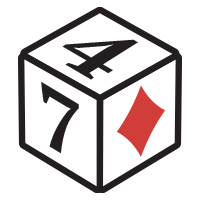We look down at in the small blind. When the under-the-gun player raises and it folds to us, we fold.
We look down at in the small blind. When it folds to us, we fold.
We look down at in the small blind. We fold.
All right, how about on the button this time? Under-the-gun raises, it comes to us, and we fold.
This time we got on the button. This is a really nice hand, so we fold.
All right, so it's pretty ridiculous, but this is all part of an experiment that I've run over the course of 5,000 hands, and we're going to get into it right now. We're going to call this the OMC experiment (Old Man Coffee Experiment), also known as the Super Nit Experiment.
The Old Man Coffee (OMC) Experiment
Hello, poker crushers and small sample winners. I'm the Tokenator, and this is Game Theory Impossible. Today we're finally back at it again. We're taking a look at a new experiment. If you're new to the channel, you might not know this, but occasionally I like to put on a little experiment where I try a new format or very simplified strategy, mostly at the micros, and I try my best to make it profitable.
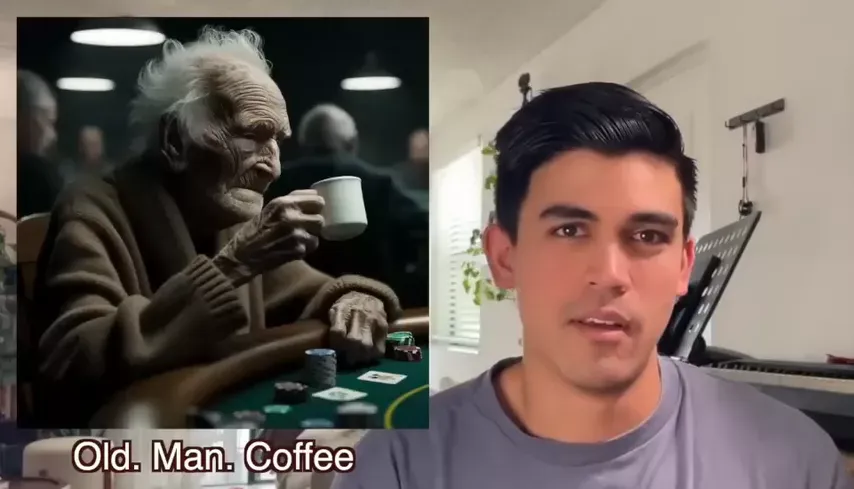
In this video, we're going to take a look at a very ridiculous strategy, one that I've been inspired to do based off of all of the comments from the last video. If you watch that video, you may be one of the people who thought I didn't play nitty enough. So I thought to myself, you know what, if we're going to do this again, we're going to do it right. And so this experiment was born.
I've got to say, it's been almost 2 years since I did my last experiment, and in that time, I've been playing a ton of poker. As a result, I've learned a ton of stuff about poker, my personal strategy, and what tends to work, especially against weaker opponents. As a result, in this OMC experiment, I had a different way of thinking about it than I did in my past experiment.
The Original Nit Experiment
In the original nit experiment, I theorized that the nit strategy would not be profitable or at the very best break even over a decent sample because:
a) You would be extremely exploitable
b) You would not be having a very good non-showdown winning line (otherwise known as the red line)
Now, the red line is super important. Your non-showdown winnings are super important because in poker, we cannot control the outcome of a specific hand in terms of we can't control whether or not we hit our hand. So we have to have multiple ways of winning a hand, and one of the really lucrative ways of winning a hand is by bluffing and/or by protecting your hand.
If you have a hand that might be best but doesn't have a ton of equity versus their hand, let's say you have a hand like and the board ran out , you probably have the best hand in a lot of situations. But you also aren't going to like seeing basically any turn card. If you're the raiser in that situation, that might be a spot where you can bet because you might force your opponent who has or to fold. So yes, you've had the best hand, but you're able to turn your maybe 60% equity in the hand to 100% equity by them folding.
In my original nit experiment, I believed that by not including a lot of bluffing and by playing very nitty, we would lose out on all of that equity, and that would be a big problem. In theory, it would be, except for one thing: we're playing micro stakes, and people play horribly. In fact, people play so poorly that my new scope of this experiment is to use it to prove how soft micro-stakes are.
Micro Stakes and the New Experiment
For preflop, here's my under-the-gun range, as you can see here, very tight. We're only going to be playing or better and . That's roughly 3.5% of starting hands. That means that over 96% of the time, we're going to be folding.
Now you're probably wondering how is this ever going to be profitable. You're going to be folding 96% of the time, and how are you going to make enough off of these hands to earn anything in the long run, especially given that we have to pay blinds, of course. That's a very good question, but first, let's look at the rest of our pre-flop strategy.
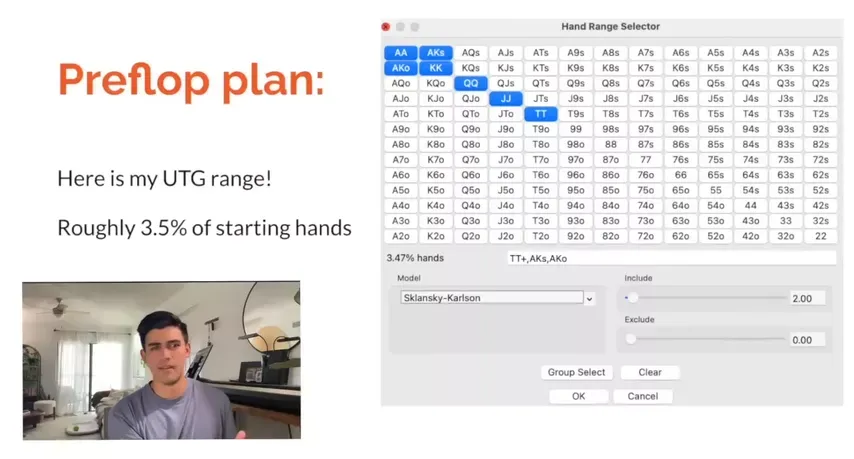
Here's our button range. As you can see, we're going to play or better and . Yeah, we're going to still play roughly 3.5% of hands. So we have the exact same range on the button, under-the-gun, and all the positions in between. Here is our raising range from the blinds and calling range from the blinds. Again, the same strategy: or better and . Pretty ridiculous and very much like an OMC.
One of the caveats to this strategy is because we're playing micros, there is actually a fair amount of limping pre-flop. As a result, on our big blind, we will be able to check our option with the rest of the 96% of hands pretty often actually.
- Postflop Strategy:
Now let's get into our flop, turn, and river strategy. Let's talk about post-flop. Post-flop, we are going to often be the raiser, right? Because we are playing the best hands only. So that means if we're not the initial raiser, we're probably going to be the 3-bettor and very often the 4-bettor. Sometimes we'll call 3-bets, but most of the time, we will be the aggressor.
As a result, the main focus here is what are we betting, and the answer is basically everything. We're betting very often because if you think about it, we almost never have bluffs in our range. The only bluffs we'll have is a hand like that's our only non-paired hand when the board comes low. So we're going to use very frequent bets, and we're actually going to use sizings based off of pretty much Game Theory sizing approach.
So in this situation, for example, on with , pretty sure that's going to be a small bet in position as the raiser, and that's what we choose to do. In this specific hand or this specific flop texture with this orientation, we're going to be betting 100% of the time.
Now if we're out of position, like in this example where we have and we were in the small blind, this is clearly a 3-bet pot and we are up against the under-the-gun raiser. We decide to bet small here. As you can see, we're going to do the same kind of strategy again for the same reasons. We basically have no bluffs ever, and the only difference is we're going to probably lean toward smaller bets out of position in general.
Obviously, on , that's a good board to bet small on because if they have a , we don't want to just bloat the pot for them, and if we have a , we don't want them to fold. At the same time, we want to get value with our strong but not exactly nutted hands.
- Turn Strategy:
Our turn strategy, since we're going to be betting the flop basically 90% of the time, will be checking quite a bit of turns. This is because our opponents are going to be continuing with a lot of hands, and we're going to be betting with some second pairs here and there and some overcards. There's going to be a lot of turn cards that we don't want to continue blowing up the pot because a lot of our hands are going to turn into marginal hands by the turn.
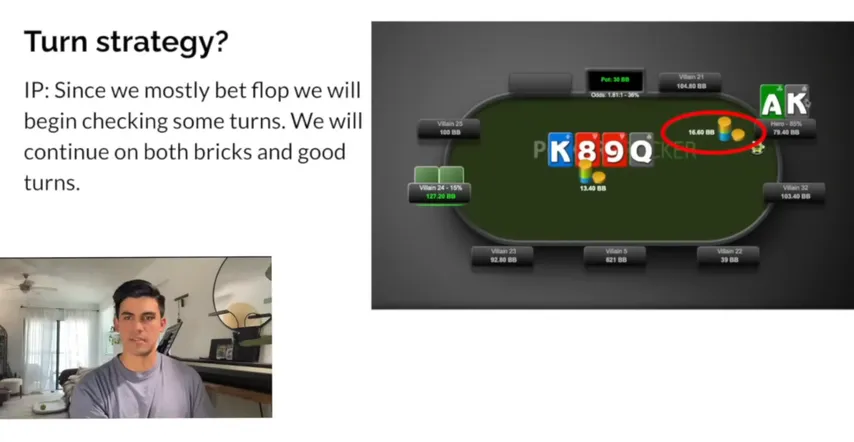
With this in mind, we'll continue on bricks with our strong hands and good turns with a combination of our strong hands and kind of our marginal hands. As you see here, this is the same hand from before. We had the , we bet the flop small, he called, and now we get a on the turn. We have a very strong hand here. Obviously, and would be better, but given that the is good for our perceived range, this is a perfectly good card to continue barreling with.
We're going to barrel big given how many draws are out there. Obviously, got there, but theoretically, we could have in their eyes. Obviously, we don't in this situation, but I still think at these micros we get to bet very aggressively with our strong but not necessarily premium hands. So we over-bet the pot here out of position.
The plan is to check more on bricks when our hand is not very vulnerable. So essentially, we're just going to be playing very straightforward.
In this hand, we 3-bet pre-flop out of position, as you can see, with Aces.
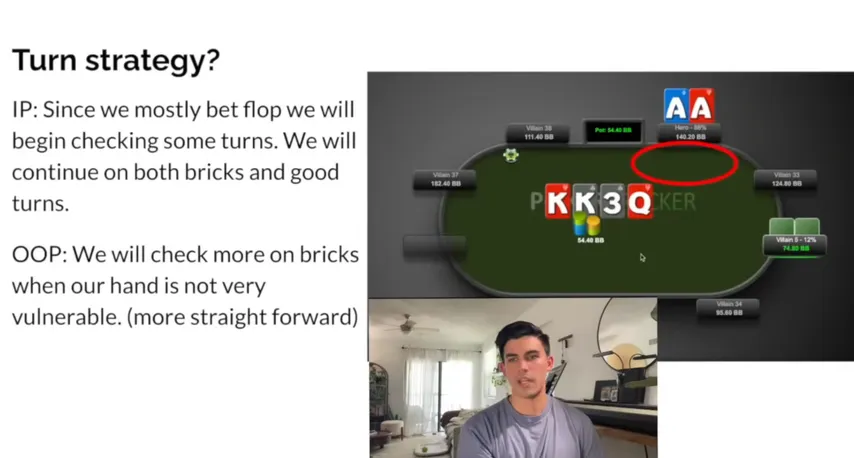
We c-bet the flop, and the turn brought in the , so there's a double flush draw on board. But the flop was a double . We don't want to continue bloating this pot with our . It's a very strong hand, but also it's not super vulnerable. The only card we really don't want to see is going to be a here, so we can check, and we obviously can call basically any bet.
- River Strategy:
Our river strategy is going to be a bunch of showing down and also fake value betting. In this example, the comes out on the river on . No flush comes in, no further straights come in, and we decide to value jam our top pair top kicker for over the size of the pot. This is a perfect example of just betting your hand. Pretty simple stuff at the micros.
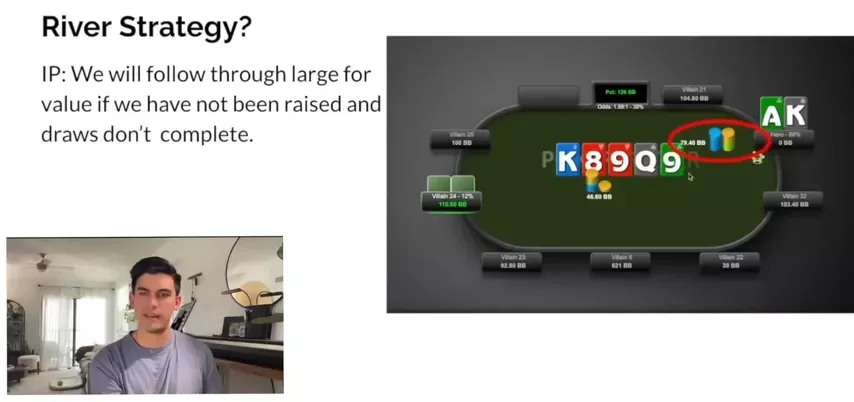
When we're out of position, we're going to be doing a ton of checking when draws come in and/or betting small. In the top example here, that's the hand again. We checked the turn if you recall when the turned, and now the backdoor flush draw comes in. We're not concerned at all about it, but we are concerned about getting value here, so we check. I think that's okay, though I think in this Aces example, the small bet also works perfectly fine. We could get called by a ton of hands like pocket , , , .
In this bottom example, we have here on this river, and you can see that we flopped a set on and we barreled. Now the river brought in a one-liner to a , so any makes a straight here. However, we bet pretty hard on the previous streets, and it's very hard for villain to have a naked gutshot here. So we decide to go with a small bet with the intention of folding to a raise, and I like this. The reason being that he's just not going to exploit us by raising as a bluff, and we are still going to get called by a ton of hands like , , , all of those two pair holdings that would not have bet themselves.
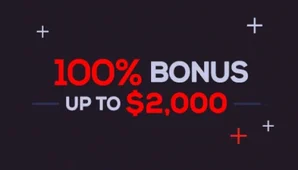


Bluffing Strategy
Now let's talk about bluffing. We're playing as an OMC, we're playing as a nit. Does that mean we're not going to bluff at all? No, we're still going to bluff somewhat, but we're going to really try and pick our spots wisely. Since we don't have any hands besides that are not a pair, we will have almost no bluffs on most boards. That means that when the board comes out -high or lower, is going to be our primary source of bluffs.
I'm not saying we're just going to bluff it off like crazy because again, we're playing like an OMC, but we'll choose our spots and look for boards that are very disconnected to put in occasional large bets with our .
This will be a great way to represent our overcards and put a ton of pressure on villains' underpairs, you know, kind of third pair type holdings and overcards that have equity like on a -high board.

Another opportunity that presents itself for bluffing is when people limp pre-flop. We kind of mentioned this earlier, but people tend to limp pre-flop, especially fishy players. As a result, when we're on the big blind, we get to check our option. Obviously, we're only playing plus and , but if it's free to play, we get to check our option. As a result, we might be in there with Six-Deuce and totally whiff a flop, but if the flop texture seems good for a big blind player and we sense weakness from our opponents, we might be able to steal occasionally.
Finally, we will occasionally have to bluff underpairs in 3-bet pots as the 3-bettor. Well, we don't have to do this, but I think it'll be profitable. The example we see here on the right, we had , we 3-bet in the small blind, and we whiffed on . The flop went check-check, and the turn brought the . We decide to bet here with our underpair because if you think about what our range looks like, we have literally no bluffs. We have , , , , and and . If we want to check some marginal hands, that hand is not going to be here, it's probably going to be . So becomes the perfect candidate to bluff with, also because we block the straight.
Thesis Statment for the OMC Experiment
So what is our thesis going into this experiment? First, let's look at what our thesis was for our previous experiment nearly 2 years ago. In that, I expected to show a loss by taking a nitty approach. Given that was nearly 2 years ago, we've actually learned quite a bit since then.
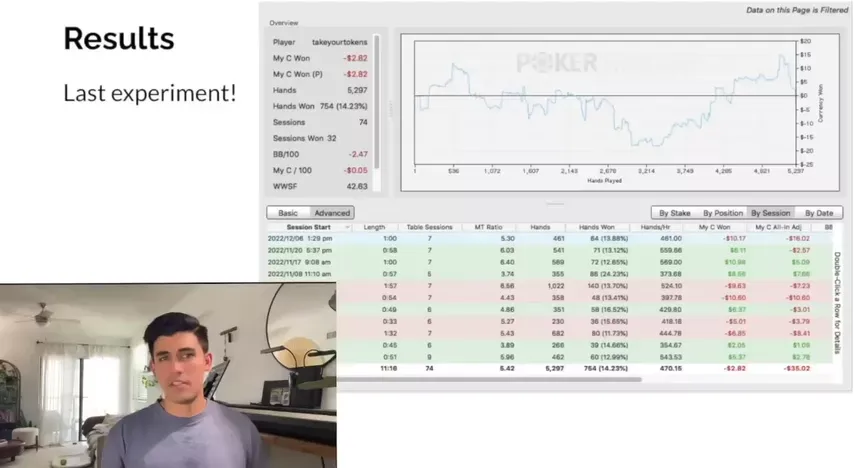
Now my new thesis is that at the micros, people play so poorly that we could potentially sit around like an OMC and literally just wait for plus and and somehow still turn a profit. This comes from my new experience since the last video, realizing what the true leaks of our opponents are and the reality that playing against this kind of player pool, the real money comes from just betting for value. So always having the stronger hand, or having the stronger hand as often as you can, and the reality is what that requires is sitting around and folding.
Results of the OMC Experiment
With that, we played 5,000 hands and ran this experiment. Let's take a look at the results.
In this experiment, as you see, we are playing 3.5% of hands, so we really went extreme here. Let's see how we did.
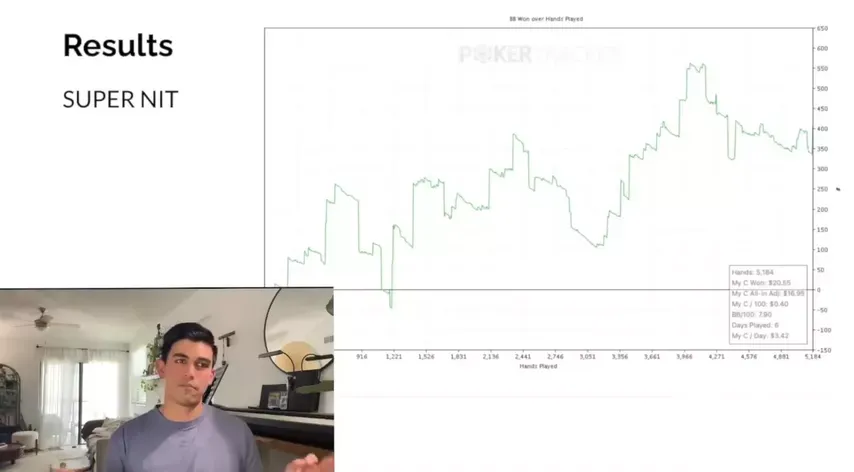
This is the results from the super nit experiment after 5,184 hands. We won $20.55. Doesn't sound like a lot, but mind you, we're playing a combination of 1 cent/2 cent and 2 cent/5 cent, so it's actually quite a bit for these micros. In fact, it is almost 400 big blinds between the two of them.
You can see that our big blind per 100 was 7.9 big blinds per 100, which is a terrific win rate if you ask me, online. Yeah, pretty amazing after just playing nitty. Pretty sad to see honestly because I think it's super boring to play this way, but we just have to deal with the reality that we've been handed, which is that at micros, maybe the best way to play is to just play tight and get value.
Findings from the Experiment
Let's take a look at some of the findings that we made or that we extracted from the hands that I reviewed:
1. At the micros, players like to end the hand. They like to end it as quickly as possible. What I mean by that is they like to just stick their stack in the middle and just make the decisions over with.
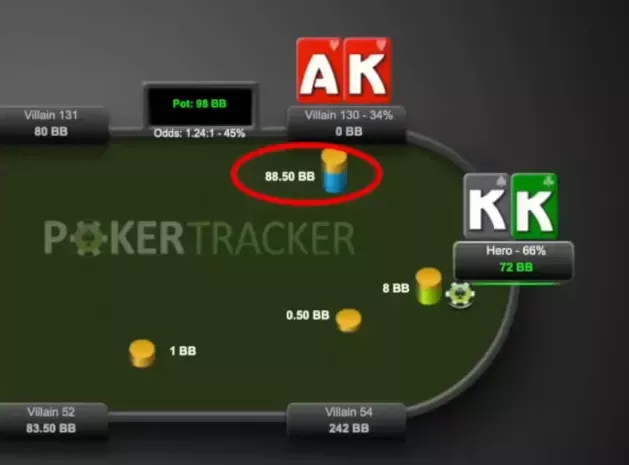
2. Players don't like to give up on hands. This is especially true in 3-bet pots or pots that tend to blow up early. We made a lot of our money from winning these all-in pots with a lot of equity, and we actually lost a lot of money by our occasional bluffs.
3. In our strategy at the beginning, when we were trying to find if we were going to bluff or not, we decided we would have some bluffs and we would pick them wisely. But it turns out that it's really hard to do, and that's partially because we were going to be bluffing mostly in these limped pots where the rake is very, very high and the pots are very, very small. As a result, my conclusion is: even if a bluff seems like it's going to work fairly often, just be careful about what you're actually bluffing for.
Really pay close attention to how big the pot actually is after the rake and be careful and mindful of that. Basically, it's just not worth it to bluff in a variety of spots, even if the bluff seems good.
4. The next thing is, we obviously want to fast play, especially versus recreationals, and a big flag for that is looking for non-maximum stacks. So if the buy-in maximum is something like 100 big blinds, look for stacks like 39, 50, 76. These players are going to pay you off if you fast play and they have anything. So in these spots, I like to just bet-bet-jam or bet-they-raise-I-just-jam with not that strong a holding because they will just never fold a top pair and always have random hands like that.
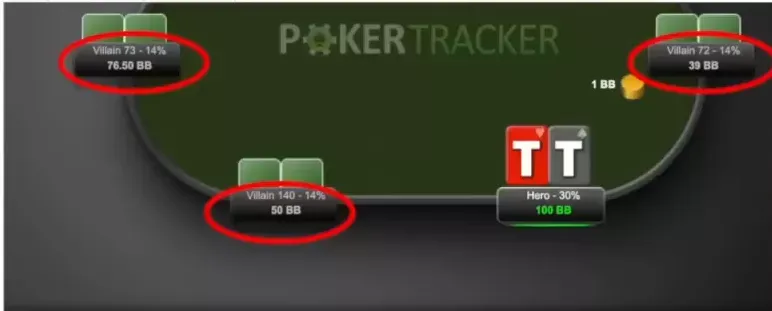
Finally, the player pool bets far too large with value holdings, making folding easy in a lot of cases. This kind of goes along with the first point, which is at the micros, players like to end the hand. This is true not only pre-flop but also on the flop. You'll see it often where you'll be in a four-bet pot where the flop has like 50 big blinds in it and both players still have like 75, and the villain will just jam 75 and you just fold, right? Unless you flop a set or you have something really, really strong.
They're just wasting so much value there when they do that. It's a terrible habit that they have. They think it's not bad because they don't really see how they're losing because they're technically winning those hands, but that's a terrible strategy that we get to take advantage of by overfolding in those spots and calling when we have the top of our range.
Here we can see my results broken up into position, and you can see by far our big blind is our biggest loser, as expected of course. But notice we're losing more big blinds per 100 than if we just pure-folded our big blind, and that is likely attributed fairly largely to these limped pots where I potentially tried to bluff a little too often.
With that, let's take a look at some hands from this experiment that are going to showcase our findings and kind of exemplify our strategy that we set out to accomplish.

Here are the full hand breakdowns from the OMC Experiment, in a separate video.
Conclusion About the OMC Challenge
In conclusion, at the micros, even without table selection, you can turn a profit by simply playing 3.5% of hands. As you saw, we didn't play perfectly. We made quite a bit of mistakes. I showed you quite a few hands where I played very poorly and it cost me, and yet we still ended up with a win rate of somewhere above seven big blinds per 100 hands.
I've got to say though, it works best at full-ring tables, and the reason for this is obviously because you just pay less in terms of big blinds and small blinds per hand. If you think about it, when you play at a 9-handed table, you get to play nine hands per 1.5 big blinds that you pay, whereas if you sit at a six-max table, you get to play six hands per 1.5 big blinds that you have to pay. So you're paying a lot more frequently, and as a result, it's a lot more money over the long run. So full-ring tables just allow you to sit around for a longer period of time and play fewer hands. You get away with it more.
We can see that reflected here by looking at our stakes. As you can see here on the 6-max stakes, both of them we lost money. At the 2-cent/5-cent, we lost over 200 big blinds, and at the 1-cent/2-cent stake, we basically broke even.
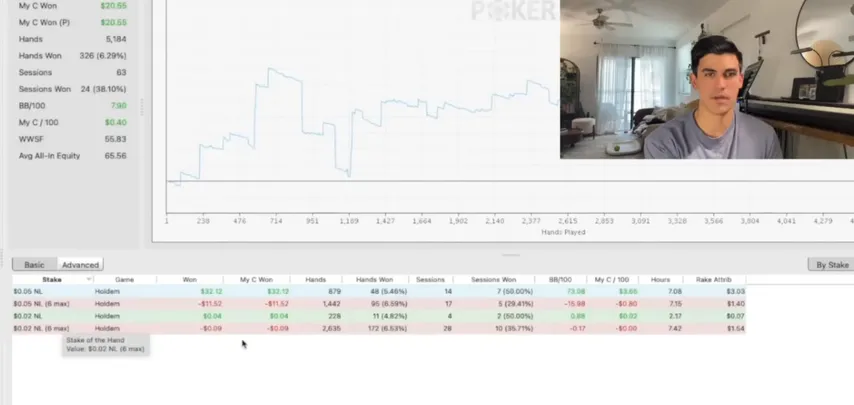
Finally, the last conclusion is you can bluff, you just have to be very, very careful about it and you got to pick your spots very wisely. You got to do it more wisely than I did. You got to be even more patient and you don't have to fight for all the small pots. Just think about how intense the rake is at these stakes.
But the bottom line is, if you play very few hands, you play only the best, just by having the better hand than your opponents most of the time, you're going to make a ton of money playing micros. So if you're one of those people that's been struggling at micro stakes, look, all you got to do is play plus and . It's really not that hard. Just play strong hands, have the better hand, bet big, get value, make folds. Not hard, just be disciplined.
Honestly, for most of the sessions that I played, I was cooking dinner, watching Netflix, I was doing something else while I was playing all these hands because it's super boring. You're just doing a lot of folding. With that, run like the sun and do your best to have fun.




